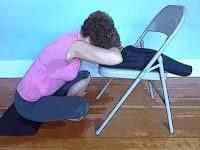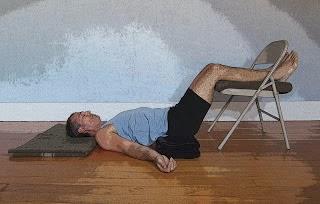One of the workshops I teach regularly with my colleague Bonnie Maeda is Yoga for Heart Conditions. Bonnie and I believe that yoga can be so effective for the management of heart disease because it is a holistic health approach that takes into account all of the varied systems of the body —in yoga, the body is part of a greater whole. Yoga is also accessible to all who want to practice, no matter what their physical ability may be. And yoga’s powerful stress management tools, including learning to slow down and breathe deeply, have many beneficial effects on heart health. Several scientific studies have now demonstrated conclusively that learning to breath deeply decreases blood pressure and slows down heart rate by stimulating the parasympathetic nervous system (Relaxation Response) and slowing down the sympathetic nervous system (Fight or Flight Response). And once you learn to become mindful of your breath and of how your body can feel when it is in a relaxed state as opposed to a hyper-arousal state, then conscious, healthy eating is a natural sequel of the yogic approach to health. Finally, learning to move your body (which nourishes all the musculoskeletal, respiratory, lymphatic, and circulatory systems) will help improve heart health.
Today I thought I might give you a little background about heart health, share with you some statistics that I find fascinating, and provide an overview of how yoga can help with heart conditions. To start, the cardiovascular system is made up of the heart, arteries, veins and capillaries, and a pulmonary circuit that transports blood to and from the lungs. The system functions to circulate blood throughout the body, bringing nutrients and oxygen to each and every cell as well as collecting waste products from cell metabolism for elimination by the lungs, skin, kidneys and intestines. The system also functions to deliver hormones and enzymes to specific tissues.
The heart is actually a muscular organ about the size of your fist. The outer layer of the heart muscle is called the myocardium. The heart has four chambers and four valves that function as one-way doors to keep the blood flowing in the proper direction. The heart has its own electrical system that triggers each heartbeat, a regular, coordinated cycle causing the chambers to relax and contract and pump blood through the entire body. There is also a separate artery system (coronary arteries) that runs through the myocardium ensuring that the heart itself receives oxygen and nutrients
Various cardiac conditions include;
- Hypertension: higher than “normal” blood pressure
- Hypotension: lower than “normal” blood pressure
- Atherosclerosis: accumulation of smooth muscle cells, lipids and connective tissue inside the inner most layer of the arterial vessels(plaque build up)
- Coronary artery disease: the three major coronary arteries may be blocked or damaged, and there is decreased blood delivery to the heart muscle
- Congestive heart failure: a clinical syndrome where the heart fails to propel blood forward normally, resulting in congestion in the pulmonary and or systemic circulation, and the diminished blood flow to the tissues causes reduced cardiac output
- Heart attack (myocardiac infarction): occlusion of the coronary arteries with death to the heart muscle cells.
- Dysrhythmias: faster than normal heart rate (tachycardia), slower than normal heart rate (bradycardia), irregular heart beat.
- Heart disease is the number 1 killer in the modern world and more women than men suffer heart attacks.
- Hypertension (high blood pressure) affects 1 in 6 people in the western world and 1/3 of them are unaware they have hypertension.
- Angina (heart pain) attacks most frequently occur between 10-11am.
- Most heart attacks occur on Mondays and more occur in the winter months.
- Emotional stress will most often precipitate heart attacks in women.
- Physical stress will most often precipitate heart attacks in men.
- Dissatisfaction with one’s life, loneliness and unhappy marriages (or relationships) can also increase cardiac risk factors.
- Inflammation, like gum gingivitis and rheumatoid arthritis, is a major factor in heart disease.
- Stress hormones will raise blood pressure and increase heart rate with increasing strain on the heart itself and increasing its need for oxygen.
- Stress will often cause coronary muscle spasms. It takes the body three hours to recover after an episode of intense anger.
So how does yoga fit in with the management of heart conditions? What stimuli do we want to encourage to soothe the nervous system, which in turn affects all the major organ systems in the body? In her post, The Relaxation Response and Yoga, Nina mentioned all the different ways we can use yoga to switch our nervous systems to Relaxation mode, including meditation, breath practices, restorative poses, Relaxation pose and yoga nidra. Deep, slow breathing, including ujjayi breathing and alternate nostril breathing, is found to be extremely effective in calming down our central nervous system. Please refer to Nina, Baxter, and Timothy’s excellent posts on the breath.
Additionally, yoga poses, including both partial and full inverted poses, that stimulate the baroreceptors naturally reduce blood pressure and show the heart rate. Please refer to all the posts that Nina, Baxter, and I have written about what baroreceptors are and how they may be modulated by positional changes of the body. Although there is some disagreement among various sources on which poses to avoid and which to include when trying to manage hypertension (essential idiopathic hypertension), the poses most frequently recommended for their calming benefits include:
Inversions
- Relaxation pose (Savasana) with legs on a chair
- Legs Up the Wall pose (Viparita Karani)
- Supported Bridge Pose (Setu Bandha Sarvangasana)
- Headstand (Sirsasana), if it is already part of your practice and is comfortable for you
- Shoulderstand (Sarvangasana) if it is already part of your practice and is comfortable for you
Forward Bends
- Seated Forward Bend (Pascimottanasana)
- Head-Knee Forward Bend (Janu Sirsasana)
- Other forward bend variations
Now some of you may read this list and say, “ I can’t do any of those inversions” or “ I can’t do any of those forward bends.” But the key principle here is how might you modify these poses so you CAN safely do them when considering all the other medical conditions you might also have. For example, propping yourself higher in a seated forward bend, as shown below, can make the pose accessible (and safe) for you.
 Everyone can sit on a chair and drape their bodies onto a table or desk for a supported forward bend. And even if you can’t do a classical inversion, everyone can modify Legs Up the Wall pose. It can easily and accessibly be done in bed if there is an available wall for you to put your legs up on or you practice Easy Inverted Pose, which is a bent knee version of Legs Up the Wall pose.
Everyone can sit on a chair and drape their bodies onto a table or desk for a supported forward bend. And even if you can’t do a classical inversion, everyone can modify Legs Up the Wall pose. It can easily and accessibly be done in bed if there is an available wall for you to put your legs up on or you practice Easy Inverted Pose, which is a bent knee version of Legs Up the Wall pose. Again the intention is to practice safely and wisely and to try not to put up barriers to prevent yourself from practicing daily.
Again the intention is to practice safely and wisely and to try not to put up barriers to prevent yourself from practicing daily. I’d like to let our San Francisco Bay Area readers know about an upcoming workshop on this topic that Bonnie Maeda, RN and I are doing on December 21, 2013 at Brentwood Yoga Studio in honor of the winter solstice! In this three-hour workshop we’ll be discussing general cardiac physiology and actions, and how the practice of yoga can be an adjunct to self care and health management.
Happy Solstice and be well.

